- Know about the different type of clothing in Nagaland/Arunachal Pradesh and what they symbolise. Plus lots of pictures.
Nagaland
is one of the seven sisters in Northeast India. Region is totally hilly. State
has 16 tribes, is best known for annual Hornbill
Festival and cane products. Every tribe has different traits, its own designs and motifs for shawls and sarongs. The dress reveals a person’s status in the tribal hierarchy. Dress materials made on age old looms. During visit to Hornbill Festival that red colour featured in most tribes ka clothing.
Yimchunger
A
huge variety of shawls exist amongst the Yimchunger Nagas.
Rongkhim
shawl can be worn only by a renowned warrior. The red color found in that shawl
represents the blood of the enemy. It is to be worn only by warriors. If
someone else wears it, it is believed that person will die of leprosy. In the
order of merit, Kechinger Ronfkhim is the warrior shawl of second rate honor. A
man who has taken the right hand of the enemy can wear this shawl. This shawl
is a black cloth having two narrow grey bands at the two edges.
Tsungrem khim is a female
shawl. Sangkonglim khim or long drum shawl is a unisex shawl. Amerthre khim shawl can be worn only by
a person who has killed a tiger. A wealthy Yimchunger man wears Rehuke khim or
cowrie which is the most important cloth for him. The shawl for a common man is
a black one by the name Aneadk Khim. Note that Mokhok Khim is a simple white
shawl devoid of any design which both men and women can wear.
Women
wear two types of skirts namely -
(a)
Kechingperu khim is a skirt i.e. is given
to a child when required. This skirt is a white cloth bearing narrow black and
red bands at normal intervals; these bands keep alternating with white.
(b)
Langa Imjung, also called Alongza
khim is a skirt worn by wealthy women.
Sangtam
The
symbols and designs found in the textiles of the Sangtam tribes are somewhat similar
to the ones found amongst the Aos and the Yimchungers.
The
famous Sangtam Rongsu is a warrior shawl which only a select few can wear. You could
find four grey band on the top of a cloth on a black base and four more bands
of the same shade at the bottom.
Supong
is a decorative shawl that can be worn only by wealthy men. The Sangtam
tsingrang su is a special shawl for aristocratic Sangtam men.
Sema
Weaving
is practiced less in Sema villages as compared to neighbouring tribal villages.
Having said that, of late women of this tribe have taken to making shawls and
skirts which are appreciated for their delicate vibrant patters.
Akhum,
the most common Sema cloth is black with three or four red bands. It can go
with various designs. It is generally worn by wealthy men.
Avi-kiyi-phi
is a cloth worn by the Sema warriors of substance. A rich person may wear if he
has offered the feast of merit by slaying mithun (buffalo look-alike of
north-east). Avi-kiyi-phi is a white cloth having nine white bands at regular
intervals.
Konyak
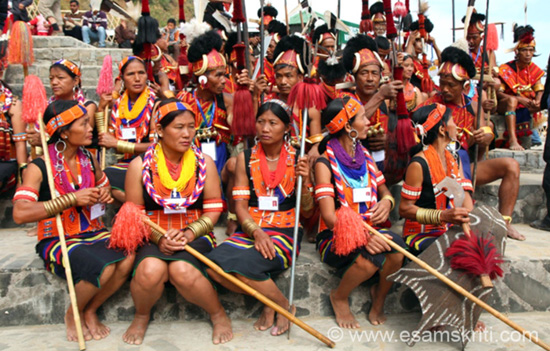 Hornbill Festival 2014.
Hornbill Festival 2014.
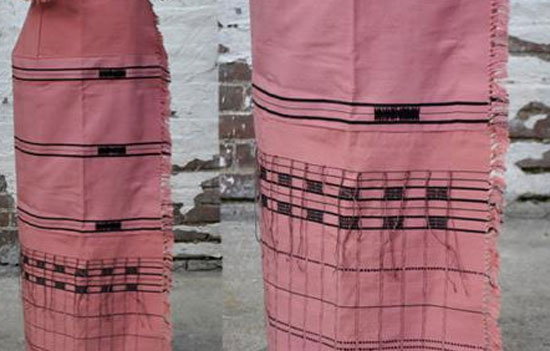
Pic credit https://www.nagalandonline.in/about/profile/culture/weaves-and-textiles-of-nagaland
Among the Konyaks, only a few variety of clothes can be found. The elderly people of the village wear a shawl called nye-myon while attending important meetings and conferences.
Nikola
is a white shawl worn by women. In the middle portion of this shawl, a pair of
narrow black lines and in between these two lines a lozenge pattern is woven in
red.
A
wealthy Konyak woman wears a vibrant and good-looking shawl called shatni. On his daughter’s marriage, a rich man is found to present a shatni which she preserves during her lifetime. This shawl is used to wrap her body after she dies.
Meyni
is the aristocratic shawl which is used by the chiefs and elders among the
Konyak tribe. Nyauni, a combination of red bands and red lines, is worn by the
rich Konyaks.
Ze-liangs-rong
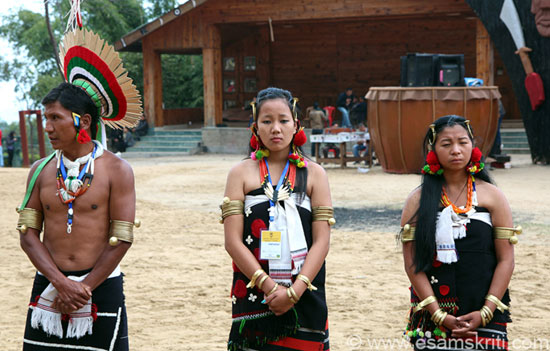 Hornbill Festival 2014.
Hornbill Festival 2014.
Quite
a few varieties of clothes are worn by the Ze-liangs-rong tribe. It is a
mixture of Zemis, Liangmais and Rongmei, as evident from the very name of the
community.
The
usual pattern is a white cloth with six black bands at both the edges. The
black bands keep varying in their sizes. The skirts of the Zemei are white with
a thin black and red border. The women make shawls and skirts from cotton grown
in home and the color of the attire is either white or beige. These have black
bands of different widths along the border which are separated by pink and red
borders.
The
popular skirt worn during dancing is black in color with a wide and a red
border embroidered elaborately and also three white median bands with a narrow
red line in the middle.
Rengma
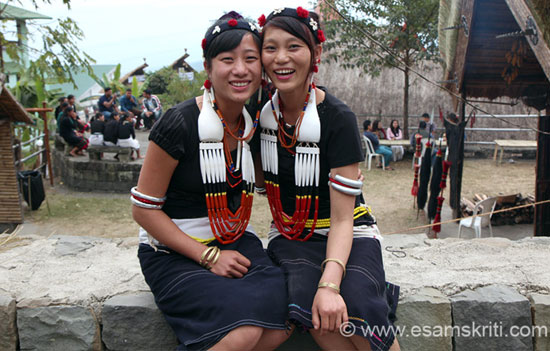 Hornbill Festival 2014.
Hornbill Festival 2014.
A
huge variety of patterns can be found in the clothes worn by the Rengma tribe.
A man who has not yet been able to offer any feast of merit or even take the head of his enemy can wear an ordinary cloth called rhikho. It is a white cloth having four thin black bands. This cloth is worn by both the young and old. A dark blue cloth with a very wide median band having a thin zigzag pattern embroidered in red at the edges is a kind of cloth for which no ritual is required. It is called the Moyet tsu and is mainly a young man’s cloth. The rich men wear alungtsu is a cloth.
Eri
Phiketsu is a Rengma shawl of significance since for it the performance of
head-hunting ceremony is imperative.
Phom Nagas
 Hornbill Festival 2014.
Hornbill Festival 2014.
Like
all the other tribes, the Phom Nagas also differentiate the patterns of their cloth on the basis of the social status of the
person.
Vihe-ashak
is the ordinary white cloth and Nempong-ashak is the dark blue
called cloth meant for casual wear. Phom fanet is the cowrie shawl which
is worn by a man who has offered feast of merit. Henyu is a red shawl having
narrow white horizontal bands at regular intervals. It is generally worn by
wealthy men.
In
recent years, this particular cloth has been selected as the national cloth of
the Phom community. Phom shungnang is the skirt i.e. worn by the Phom women.
A
phom shungnang is a black cloth having a pair of prominent stripes running
parallel to each other where each bears five thin red lines. Again shaka is the
skirts worn by the wives and the daughters of the rich Phom tribal people.
Classification of Nagaland Traditional Dresses on the basis of
tribes
Angami Tribe
 Hornbill Festival 2014.
Hornbill Festival 2014.
The
Angamis are one of the biggest Naga tribal communities. The people of this
tribe have been living mainly on the products out of the terraced fields for a few
generations. Before that they were busy hunting for a living. The women
belonging to this tribe are expert weavers.
Women
weave a variety of cloth patterns. Amongst these they mainly wear Loramhoushu
or the one having white with red and black bands and lohe having black with red
and yellow bands. Phichu-pfe cloth is worn by the priest. Ratapfe is a black
shawl i.e. worn by men and women as casual wear. Kilt which is a plain black
cloth is generally worn by men. It has the embroidery made with cowries in
three to four lines. The usual dress of the Angami women consists of neikhro or
a petticoat, vatchi or a sleeveless blouse and pfemhou which is a white skirt.
Lothas
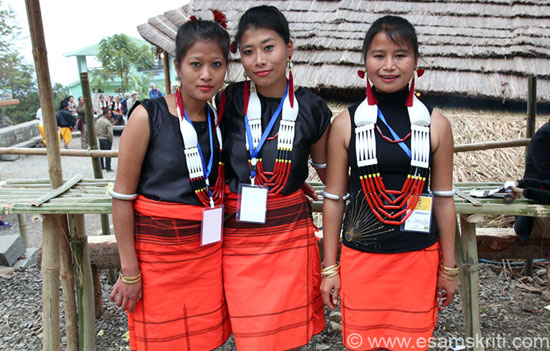 Hornbill Festival 2014
Hornbill Festival 2014
Lothas
are distinguished from shawls based on the number of gennas which are performed
by the one wearing it.
Thereby,
a person who has performed the first genna wears a shawl known as phangrhup,
the stripes of which widen after the second genna is performed by the person.
After the third genna is performed, the man can wear ethasu. Following this, if
the series of feasts are performed, and the stone-dragging is over with, the
man is liable to wear lungpensu. Lungpensu is a dark blue cloth with five light
blue coloured stripes on it with narrow stripes on both the sides.
Tsungkotepsu
It
is an AO warrior shawl which has a variety of figures including those of Tiger,
Mithun, elephant, cock, a human head, and spear on top of it. The shawl is
beautiful and attractive.
The
figures present on top of the shawl represent symbols like Mithun (looks like a
buffalo) and stands for the wealth of the person wearing it. So also elephant
and tiger represent the ability of the person to hunt, and the human head
stands for the success of the wearer in taking the number of heads. The
patterns are black in colour and are present on top of a white band. The cloth on
top of which the patterns are made is dark blue in colour.
Changs (Shawls)
Kaksi
nei is the dress worn by unmarried boys as well as girls. A newly married
couple wears the Silang nei.
Tobu
nei is a different kind of Chang shawl which has zig-zag patterns of red and
black colours alternately on a blue band. Yimchunger shawl is another variety
of shawl which is popular as are Aneak Khim i.e. black and Mokhok Khim i.e. white.
Another
shawl Rongkhim is a kind of Yimchunger shawl is worn by a person who has killed
and taken heads during wars. The shawl has a red design which is rectangular in
shape, red color denoting the blood of the enemy.
Earlier,
by just taking a look at the shawl of the one wearing it, a person could
identify his tribe, social status, the village of residence and the number of
gennas performed by him. However, times have changed now.
Kilt
Kilt
is another commonly worn dress apart from the shawl.
A
kilt is denoted as the working dress which is usually black. It is intricately
designed with cowries which make it appear like a male dress. Before the
cowries are designed on the kilt, they are rubbed on a stone so as to make them
stick well on the cloth. The man who uses the kilt is the one to sew it. Nobody
else including the wife or any other person is allowed to do it for him. The
cowries designed on top of kilt are quite popular amongst the Nagas and is
symbolic of the success of the wearer in love and war.
Note – the author does not claim this compilation to be an original piece of work. The intent is to document and promote Naga Handlooms. We have given credits. In case any credit is inadvertently missed out please email esamskriti108@gmail.com
with details and we shall do the needful.
References and Credits (pictures
of Hornbill Festival are by esamskriti)
1.
Nagaland Online – very good reference site
2.
Weaves
of North-east India includes Nagaland and Arunachal
3.
To
buy Naga shawl
4.
Naga Weaving – To read and buy
5.
To read about and buy – good blog
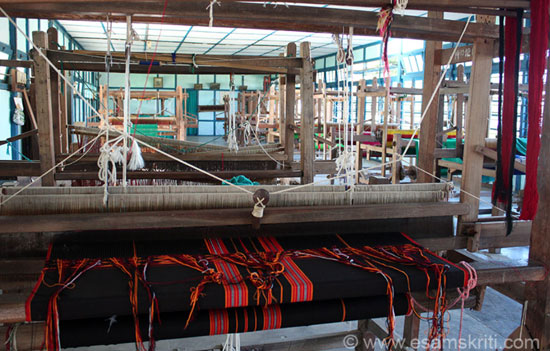 Looms, Craft Centre Tezu, Arunachal.
Looms, Craft Centre Tezu, Arunachal.
Arunachal
Pradesh
Arunachal
Pradesh is a beautiful state with lovely people. It borders Tibet, Assam and
Nagaland.
It has 26 major tribes including sub-tribes. Every tribe have unique set of traditions and customs. Arunachal’s cultural lifestyle is dominated by festivals. Since agriculture is the main occupation people generally celebrate festivals as a mark of thanksgiving to the Creator for giving them a good harvest.
Also read Mopin
Festival
Textiles of Arunachal
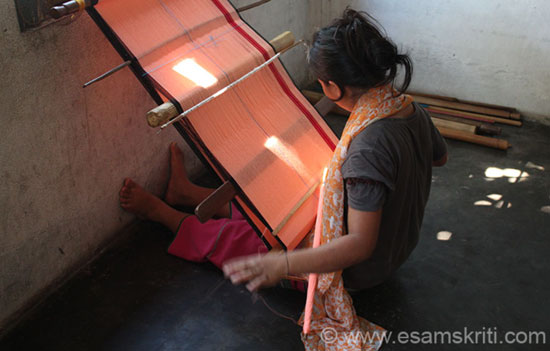 Lady weaving a Gale or lower garment worn by women, at RKM.
Lady weaving a Gale or lower garment worn by women, at RKM.
The
women fold of Arunachal Pradesh tribes are involved in weaving.
As
the warp is dense and usually covers the weft, the woven fabric is thick. The
colours and patterns are unique to the rituals and customs of each tribe and
community. Combinations of black, red and white are prominently used to weave
bold stripes into the fabric by making use of different coloured yarns in the
warp which are obtained from natural sources such as barks, roots, leaves, seeds
of trees and synthetic dyes and chemicals.
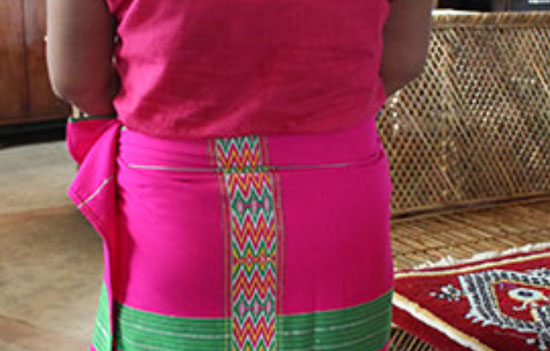 Gotak Gale.
Gotak Gale.
The
patterns may vary from the simply designed arrangement of lines and bands to
elaborate woven patterns in yellows, greens and scarlet. The patterns are
generally symmetrical as more than one width of the fabric is used to weave a
garment.
Woven items include Tudung jackets and shawls of the Sherdukpans. “Monpa bags, Apa Tani jackets and scarves.” “Adi skirts (galle), jackets, bags and scarves";" Mishmi jackets, shawls, bags and blouses.” “Wancho bags, loin cloths and sashes.” Tangsa lungis and bags. Further north, the Monpas, Membas and Bokers also weave woollen jackets, trouser lengths, and blankets.
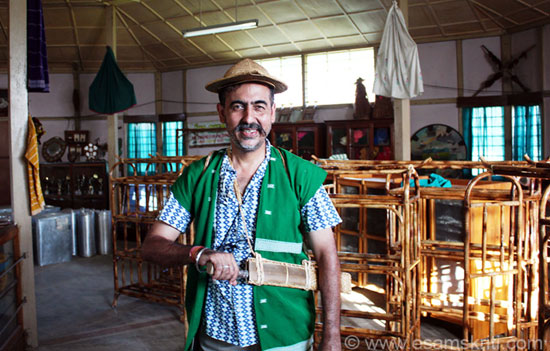 Galuk
Galuk
The
textile patterns found among the tribes of Arunachal Pradesh such as Adi,
Mishmi and Apatani are invariably of geometric pattern. Most popular motives
are Zig-Zag lines and angular designs. The floral and Zemorphic patterns are
more or less geometric form.
The
simple and straight lines, stripes and Aa bands and similar patterns are most
common. Contrasts and combination of colours are quite popular. The highly
disciplined Adi and Apatani concentrate on simple straight line, while the
strongly individualistic Mishmis go in for great celebration of pattern.
The
Adi have a great variety of straight forward patterns. There are arrangements
of red and black strips on white ground, white and yellow strips on a black
ground alternate bands of red and black ground, white bands of red and black or
of olive green and brown, broad border-bands of brown with a central narrow
strips of black and white and the body of the cloth being black with brown
black and white strips at a three-inch interval.
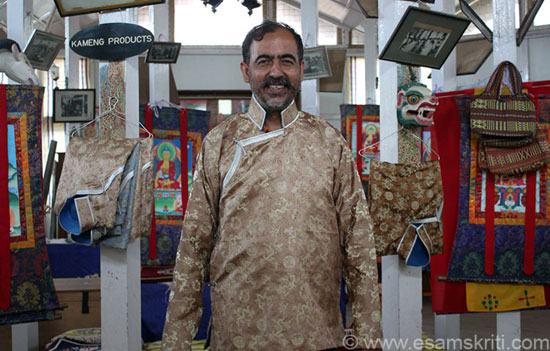 Alipundung.
Alipundung.
The
Gallong still continue the traditional design on the white clothes with broad
rectangular design across the centre. The most popular Padam Minyong skirt is
of crimson yellow colour with a vertical band which runs down the centre. The
different varieties of bands and colour make the Apatani cloth different from
that of the Gallong. The Mishmi weavings is however, more elaborate though the
straight lines and bands are in use.
The
colours and designs have their symbolic meaning among some of the tribes. In
Tuensang, the small red squares on a sanctum cloth are said to represent the
ferment used in making beer. Shapely pointed triangles are arrows or horn
bills. Circles of cowries stretched on a cloth symbolise human heads. The red
colour of the shawls stands for the blood enemies, blue stand for the sky and
black for the night.
 Carpets at Tawang
Training Centre.
Carpets at Tawang
Training Centre.
The use of certain kinds of clothes and ornaments is often associated with a family’s social position and achievements in the fields of hospitality and war.
The
Apatani priests may wear special shawl on ceremonial occasion. This shawl with
extraordinary design is said to have special powers.
One
can know about the civil status of a girl from the type of belt she wears. The
unmarried Adi girl wear one type of belt. Married women wear another. The
Sherdukpens and Hrurso aristocracy alone can wear the Tibetan knobbed bat and
in the past there were restrictions on the use of silk among the Monpas.
The Wanchoos allow only members of the chief’s family to wear a certain type of blue head on the arms and legs and have special design for their head bands. In Tuensang the dress protocol has great importance esp. because, in the past, man’s social position depended on his success in head-hunting and in giving feasts of merit.
Though
there has not been much external influence on the design of the fabrics in
Arunachal Pradesh, there has been some borrowing of motifs from the
neighbouring areas. In western Kameng for example, the influence of Bhutan and
Tibet is evident in many of the products of the Monpa loom. Monpa painting is
largely Tibetan in subject and technique. Aeroplanes are now familiar objects
all over the frontier and they appear in some recent Mishmi textiles.
Note – the author does not claim this compilation to be an original piece of work. The intent is to document and promote Arunachal Pradesh Handlooms. We have given credits. In case any credit is inadvertently missed out please email esamskriti108@gmail.com
with details and we shall do the needful.
Reference and
credits
1.
Asiainch
2. Weaves
of northeast India
3.
Weaves
of Arunachal Pradesh
4.
Idu
Mishmi textiles of Arunachal
5.
Craft
centres of Arunachal
6.
Tribes
of Arunachal
To read all
articles by author
To
read about Handloom Sarees of Odisha
To
read all articles on Traditional Textiles of India
Author Trishna
Patnaik
is a self-taught
artist based in Mumbai, Trishna has been practising art for over 14 years. She
is now a full-time professional painter pursuing her passion to create and
explore to the fullest. She conducts painting workshops across India. She is
also an art therapist and healer who works with clients on a one to one basis.
Not to forget her quality writings on Indian Art and now Textiles for
esamskriti. She fancies the art of creative writing.